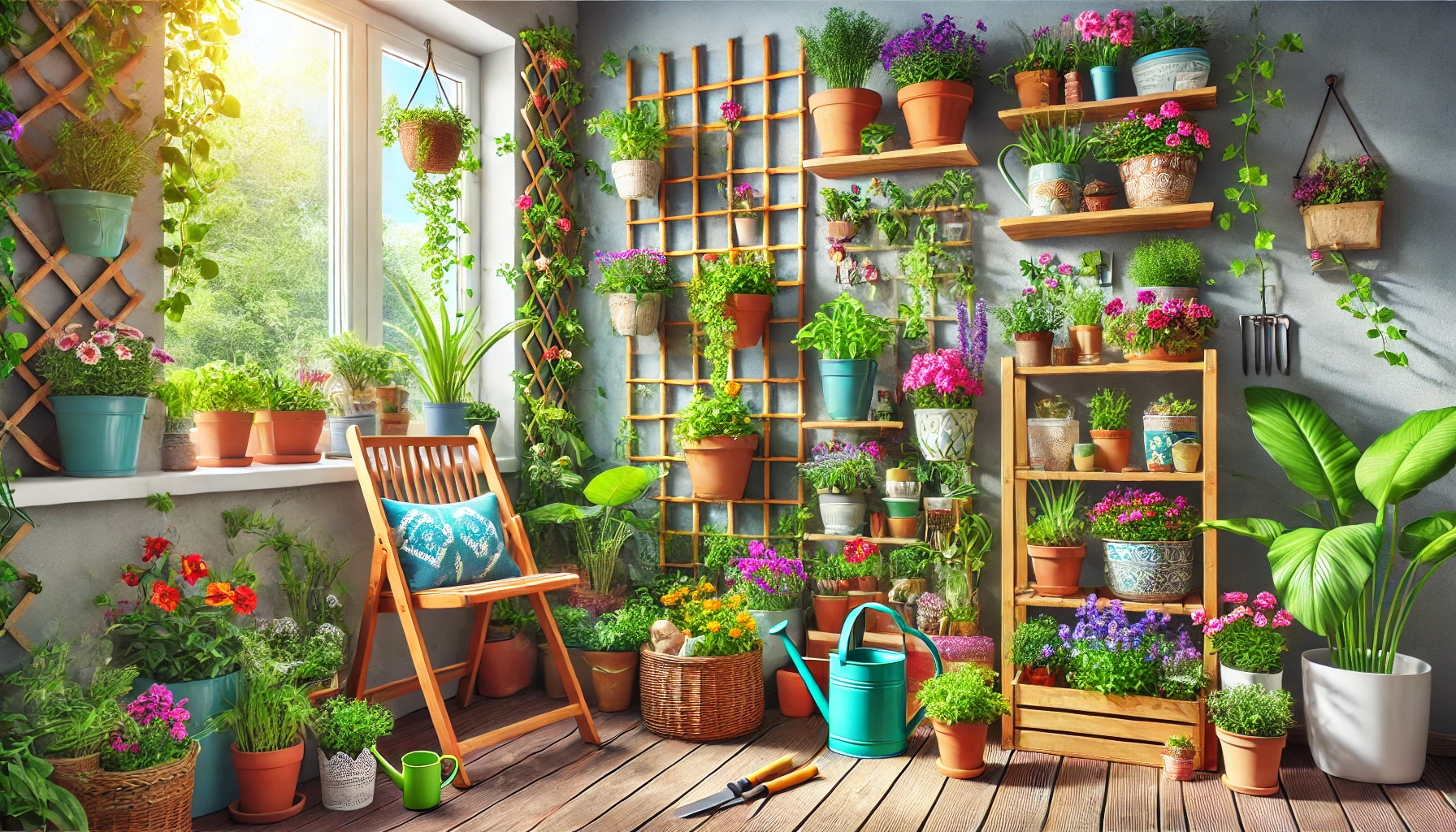A balcony garden is a fantastic way to grow plants in a limited space, adding beauty, greenery, and even fresh produce to your home. Whether you live in an apartment or want to maximize your outdoor space, a small balcony garden can bring nature closer to you. In this guide, you’ll learn how to set up and maintain a thriving garden on your balcony.
Benefits of a Balcony Garden
- Improves Air Quality: Plants filter toxins and produce oxygen, creating a healthier environment.
- Maximizes Space: Turns unused balcony space into a productive and beautiful area.
- Fresh Produce: Grow herbs, vegetables, or fruits for fresh, homegrown ingredients.
- Boosts Mental Well-Being: Gardening is a relaxing and rewarding hobby.
Step 1: Assess Your Space
Evaluate Sunlight
- Observe how much sunlight your balcony receives throughout the day.
- Full Sun: 6+ hours of direct sunlight (ideal for tomatoes, peppers, and herbs).
- Partial Sun/Shade: 3-6 hours of sunlight (perfect for lettuce, spinach, and ferns).
Measure the Area
- Measure the dimensions of your balcony to determine how much space you can dedicate to plants and furniture.
Check Weight Limits
- Ensure your balcony can support the weight of pots, soil, and other garden elements.
Step 2: Choose the Right Plants
Herbs
- Easy to grow and perfect for small spaces. Examples: Basil, mint, parsley, and chives.
Vegetables
- Grow compact or container-friendly varieties. Examples: Cherry tomatoes, bell peppers, and spinach.
Flowers
- Add color and fragrance. Examples: Petunias, marigolds, and geraniums.
Climbing Plants
- Maximize vertical space with trellises or hanging pots. Examples: Jasmine, morning glory, and ivy.
Low-Maintenance Plants
- Perfect for beginners or busy gardeners. Examples: Succulents, snake plants, and pothos.
Step 3: Plan Your Layout
Vertical Gardening
- Use wall planters, hanging baskets, or tiered shelves to save space.
- Trellises are great for climbing plants.
Container Gardening
- Choose lightweight pots with drainage holes to prevent waterlogging.
- Consider self-watering pots for convenience.
Use Every Surface
- Place pots on railings, corners, or under tables to maximize space.
Step 4: Set Up Your Balcony Garden
1. Prepare Containers
- Use pots, planters, or recycled containers like buckets or crates.
- Ensure proper drainage by adding pebbles or broken pottery at the bottom.
2. Fill with Soil
- Use a high-quality potting mix suitable for your plants.
- For vegetables and herbs, choose soil rich in nutrients.
3. Plant Your Greenery
- Sow seeds or plant seedlings according to their spacing requirements.
- Water immediately after planting.
4. Add Accessories
- Incorporate a small table or chair for a cozy seating area.
- Add decorative items like fairy lights, wind chimes, or plant markers for personality.
Step 5: Maintain Your Balcony Garden
Watering
- Check soil moisture regularly and water as needed.
- Use a watering can with a narrow spout to avoid spills.
Fertilizing
- Feed plants with a balanced fertilizer during the growing season.
- Use organic options like compost or fish emulsion for edibles.
Pruning and Harvesting
- Remove dead leaves and spent flowers to encourage growth.
- Harvest herbs and vegetables regularly to promote new growth.
Pest Control
- Inspect plants weekly for pests like aphids or spider mites.
- Use natural remedies like neem oil or soapy water to treat infestations.
Tips for a Thriving Balcony Garden
- Group Plants by Sunlight Needs: Keep sun-loving and shade-tolerant plants in separate areas.
- Rotate Pots: Move pots occasionally to ensure even light exposure.
- Collect Rainwater: Use a small rain barrel or bucket to water your plants sustainably.
- Add Mulch: Use mulch to retain moisture and reduce the need for frequent watering.
Common Challenges and Solutions
- Limited Space: Use vertical gardening techniques or stackable planters.
- Wind Exposure: Place heavier pots near the edges to anchor your garden. Use windbreaks like lattice screens if needed.
- Overwatering: Always use pots with drainage holes and check soil moisture before watering.
Conclusion
A small balcony garden is a wonderful way to connect with nature, even in urban settings. With careful planning, the right plants, and regular maintenance, you can create a lush and productive space that brings joy and greenery to your home.
